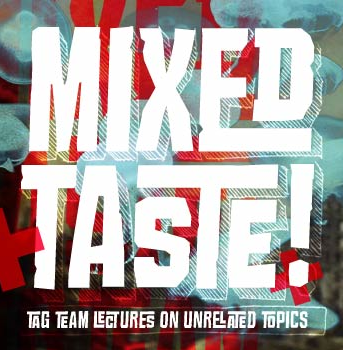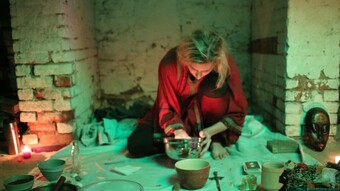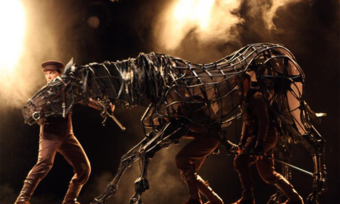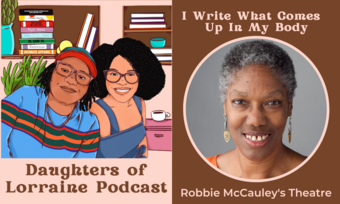#excellent2awesome (in 140 characters or less)
I set out to write this article as soon as I got home from the Literary Managers and Dramaturgs of the Americas Conference, which was held in Denver July 7 through July 10. After the initial introductions, keynote speaker Adam Lerner—Denver Museum of Contemporary Art’s Director and Chief Animator in the Department of Structures and Fiction—delivered an inspiring and hilarious keynote address. The thesis: “We spend so much time being excellent that we forget how to be awesome.” As my boss and I attended the remainder of the conference and explored Denver (kind people, clean air, cheap beer, lots of public art, and a free Pedicab ride—what's not to love?), Adam's comment played over and over in my head. How can those of us in the theater move beyond “excellence” and make a commitment to “awesomeness.” What does it even mean to be awesome? By the time I got back to D.C. on Monday afternoon, what had begun to simmer on Thursday night was about to boil over. I was anxious to sort through my thoughts and get something on virtual paper. As I sat at my computer in the office, I began to write a narrative of the weekend. Two paragraphs in, I stopped. Something didn’t feel right. The writing was overly expository, verging on didactic, and didn’t feel actively engaged with my ideas. Rereading what I had written, I felt distanced and bored, and if that was true, I couldn’t expect anybody else to get excited by what I was trying to say. Frustrated, I saved the draft and walked away from the computer, realizing that I had some idea of what I wanted to say but had no idea how I wanted to say it and hoping that some distance would provide fresh insight.
Finally, a week later, it hit me. The writing had a sense of authority (an authority that I’m pretty sure I don’t have) and was following a pretty traditional intro-body-conclusion form. Without even knowing it, I was being “excellent” in my attempt to promote “awesomeness.” I decided to spend the afternoon in a coffee shop to give it a second go. What could take this article from “excellent” to “awesome“? The answer presented itself as a hash tag. Anyone can create a hash tag, use a hash tag, understand a hash tag. Hash tags can be ironic or sincere. Hash tags embody “awesome.” Now, I’m a total Twitter neophyte (and am clearly cheating, as this article demonstrates that I’m incapable of expressing myself in 140 characters or less), but I thought I’d give it a try. So here it is, my second go: #excellent2awesome:
Tweet #1: Forego “professionalism” for humor. #exellent2awesome
So often theaters either snob up (e.g., “This is a must see. We know she’s the next big thing.”) or dumb down (e.g., “It’s just a boy meets girl love story.”). Adam Lerner suggested that humor is a “third way,” allowing theaters to connect with those attending our events as human beings rather than collective audiences. Humor is personal, smart, and easily accessible. More importantly, humor indicates that the institution cares for the audience and trusts them enough to let the walls come down a bit. If we show an audience that we’re ready to laugh with them, they’ll be more likely to cry with us, learn with us, and take risks with us. Adam threw out a handful of examples of how he has used humor in his ventures. One that stuck with me: handing out free pickles at an event. Why? “Pickles are funny. We could have given out cookies, but they’re not funny. Pickles are funny.”
In lieu of distributing awkward side dishes, how can we add levity to the theatrical experience? It’s not about more funny plays. It starts before you walk in the door. The Rude Mechs perform in the Off Center. It continues into the theater. When Edward Albee revealed himself as the cantankerous voice on the preshow announcement in Arena’s production of At Home at the Zoo, the audience knew they were in on the joke too. It can go digital. The Public Theater tweets raccoon sightings between Kushner interviews and gay marriage congratulations. The possibilities are limitless—theater is fun, even when it’s not funny.
Tweet #2: Let everyone be an expert by creating truly unique events. #excellent2awesome
Mixed Taste: Tag Team Lectures on Unrelated Topics (weekly events at the Denver Museum of Contemporary Art where two experts speak for twenty minutes on the topic of their expertise and then both experts take questions on both topics simultaneously) is fun because while each speaker is an expert on a specific topic, nobody in the room is an expert on the two topics combined. Case in point, at the Mixed Taste I attended, we heard from a woman who has practiced Santeria (a religion rooted in Catholic and Yoruban traditions) for over a decade and a curator with an expertise on Barnett Newman (an abstract expressionist painter). When time came for question and answer, however, it quickly became evident that everybody in the room was now an expert—not on Santeria or Barnett Newman but on Santeria and Barnett Newman. And it was remarkable how this newfound expertise gave the audience permission to be challenged and, therefore, authentically engaged. This shared experience is one that people in Denver don’t want to miss.
#excellent2awesome is about who is empowered to do the talking, and where that conversation happens.
You don’t have to look hard to find applications in theater. Theater is necessarily a shared experience. And each person who walks into the theater walks out with both this shared experience and with his or her own unique perspective. Take advantage of this. Facilitate dialogue—not a Q&A where audience members ask actors about where their microphone is stored or how long it took them to memorize all those lines but a conversation amongst audience members about how the play made them feel. Invite audiences into the rehearsal and development process like Steppenwolf does with First Look101. Pair plays together in unexpected ways—if you schedule a new play in tandem with a classic musical, host a themed pre-show hangout or post-show party that allows the pieces to talk to each other. Publish video interviews with actors, playwrights, designers, etc. Encourage the audience to buy in early, often, and in a way that builds upon their unique expertise, fostering a personal connection with the art.
Tweet #3: Really use “the lobby.” #excellent2awesome
Work to fully engage the audience with the space as part of the event. Do something to get the audience in the mood to play. Engage people tactilely, aurally, visually. At a recent Woolly Mammoth show I attended, each audience member was handed a label, both suggesting that the idea of labels would be central to the play and forcing me to confront how I would label myself. As I wandered around the lobby, I couldn’t help but look at how other audience members had labeled themselves. Suddenly, it didn’t feel like I was going to see a play with my friend but rather I was about to embark upon a theatrical experience with the “Kid” in the business suit and the “Committed” twentysomething in the V-neck tee.
Bring people into the space to do more than “appreciate the art.” Hand out pickles. Make the lobby a place to be. Be creative in your curation so that the audience engages not only with the space but with the people in it. One of the brilliant things about Mixed Taste is that it is housed at the Denver Museum of Contemporary Art. Spending an hour and a half at this engaging event made me want to explore the art museum (and I wasn’t the only one—the museum was quite crowded for a Friday night!).
This article started in the office, moved to the coffee shop, was emailed to classmates in New York and Providence, came back to the office, and found its conclusion at 10 p.m on a Friday evening in my apartment with a good friend. The journey was #excellent2awesome.
#excellent2awesome is not about brevity (clearly—this article is 60 tweets long). It’s about who is empowered to do the talking, and where that conversation happens. And #excellent2awesome is not about the product, though we all hope the product will be good.
#excellent2awesome is about not putting the art in a frame and hanging it on a wall for a museumgoer to breeze by on a Sunday afternoon but rather passing it amongst artist, curator, and museumgoer, allowing everyone an equal chance to feel the texture of the canvas. It’s about expanding the art beyond something that is observed in a dark theater and making it an experience driven by human connection.
Tweet #4: First attempt at #excellent2awesome. #success?










Comments
The article is just the start of the conversation—we want to know what you think about this subject, too! HowlRound is a space for knowledge-sharing, and we welcome spirited, thoughtful, and on-topic dialogue. Find our full comments policy here
I simply needed to say thanks a lot for this blog post and say hello to my peeps on the other end.
Indeed, I knew exactly what Aaron meant by "professionalism." That sterility is deadly, which is why I suggested that "engagement" is the operative word. Doesn't mean humor exclusively, but humor is certainly a component.
A theatre company's twitter feed can be extremely funny, but if it isn't engaging in conversation and interacting with its followers, it won't matter how funny it is, it's still an empty exercise and a waste of social media effort.
Or, like a certain major theatre last winter, it can let a supposedly funny character from a Christmas production hijack the feed and try to be funny without serving the followers' needs or doing anything more than the barest interaction in terms of contests and ticket sales. (Create a second account for a character and direct your followers to that, giving them the choice to follow it or not. But for many of us, we either used Muuter.com or simply unfollowed the theatre account in question for about five weeks until it reverted to normal.)
Was that account funny? From time to time, but not consistently. Was it engaging? Not a bit.
So there's more to humor in using social media.
I loved this so much.
Also, David--I think I know what Aaron means by "professionalism." The word can have a connotation of sterility. I've seen several productions at a certain big-name regional theater where every sharp topic--race, sex, class--is rendered dull by Very Careful Professional Production Values. They play it so safe, and it's so boring. I never go anymore.
But I might consider doing so, if they gave the barest indication that they weren't taking themselves so seriously....
I really enjoyed the article. As a founder of a theatre company that hasn't been around for a full year yet, me and the rest of my board sit around and ask ourselves what our identity is in our theatre community. How do we want to be identified? How do manage not to be identified a certain way? We have a strong drive to contribute art to the community, but how do we engage the community?
I truly appreciate that you don't try to illustrate how to change what's on stage, but rather what happens in the lobby before and after the show. I still worry though, as an artistic director, about being hindered by too much humor in the relationship with the community. If I give members of the audience pickles before one show, or bananas before another show, what happens when I receive a serious play about abortion or child abuse or rape or suicide, and I feel compelled to being the piece to the community. Giving out pickles and hotdogs doesn't seem right anymore and the expectation from the audience is not going to be met when there isn't something funny put in their hand before a show (Handing out canisters of mace might get misconstrued).
I really really really like the idea of having humor. I love the idea of being awesome. (I've wanted to be awesome my entire life.) But some of the ideas and social aspects of life we talk about in theatre are not awesome. When I see a great production of 'Pheadre' or ''night, Mother', I don't feel awesome inside.
So, I guess, I'm scared of being awesome and humorous right out of the gate, because the community might get agitated if we want to be serious every now and then (or maybe the majority of the time). But maybe that's the way it needs to be...
I really did enjoy the article. I could do with some more awesomeness in local theatre.
I love your enthusiasm, and welcome to the twitterverse.
I'd suggest going back and reading through the 2amt site. We've been promoting ideas like these (and more) for social media engagement with audiences, companies and artists--among other things--for the last year and a half. What you've described is just the tip of the iceberg.
There are two things in your post itself that I'd take issue with.
1. It's not about forgoing "professionalism" for "humor." That's a very shallow way to use Twitter (or any social media engagement, really). It's about forgoing "professionalism" for "engagement." This is a conversation, and while humor's an important part of that, it's only a part.
No, we don't want ticket sale information and behind the scenes peeks. We want conversation. The 2amt community, hashtag and website would not exist if it weren't for the free and open conversation available on Twitter.
Another great use for Twitter is for storytelling itself. I was doing that in 2008, connected to an original show we were producing. Since then, we've seen other artists and companies do this & have ourselves been developing an original Twitter-based collaborative play through the 2amt community. That's coming soon...
2. Hashtags are more useful than being just sincere, ironic or awesome.
For example, #2amt has thrived not because it has an obvious meaning--it doesn't--and not because it's awesome--though most who participate would say that it is. It has thrived because it is short, simple and unique. Brevity is the soul of twit. It's five characters out of 140, allowing plenty of room for the thought.
The original marathon conversation that eventually became this ongoing tag was a fluke one night. The next morning, Chicago critic Kris Vire woke up to find several hundred messages in his Twitterstream, prompting him to tweet, "Damnit, I missed the great 2am theatre summit last night." Days later, someone threw out a question and added "#2am" at the end. A few days later, another person did the same.
But there was a lot of noise on that tag, it wasn't unique. So I added a "t" at the end for theatre, and the tag has been continuously active since then with artists and companies from around the world. More importantly, there's no noise, no random tweets, because it's not an obvious phrase to type. Even #newplay routinely has people tweeting about new songs they've discovered.
The short but simple tag is also good for conferences, like #LMDA11. (If they've archived the tag, you'll find both my own Twitter handle and the "2amt" Twitter handle throughout.) Because of that, people who aren't at the conference can take part and contribute. Several times in the last year, I've taken part in tweeting with conference tags where people have been convinced I was actually at the conference in question.
So the tag "#excellent2awesome" uses 18 characters. That's assuming a given tweet isn't directed at someone or retweeting someone, which will use more characters. Hashtag jokes are often longer, but they're not meant for more than a few uses. The hashtags that catch on are generally 8 characters or less.
That said, a given thought doesn't have to be constrained to a single tweet. It's common to write (cont) or (1/2) or any one of a number of things in order to string a thought across several tweets. I often use ellipses myself.
So those are some of the basics for best practices when using Twitter. They've been working wonders for a while now, and we're helping to spread the word and teach theatres (and artists) how best to work with social media.
Feel free to join in the #2amt conversation, just search for #2amt in Twitter or in Tweetdeck (or whatever you prefer to use). It's easy to join in, there's no set topic most of the time, and there are often silly conversations going on at the same time. The only real rule we have is, don't promote a show with the tag, because most of the audience reading isn't going to see that show, they're someplace else entirely.
Again, welcome to the twitterverse. Hope to meet you virtually, and maybe even in real life the next time there's a 2amt meetup in D.C.